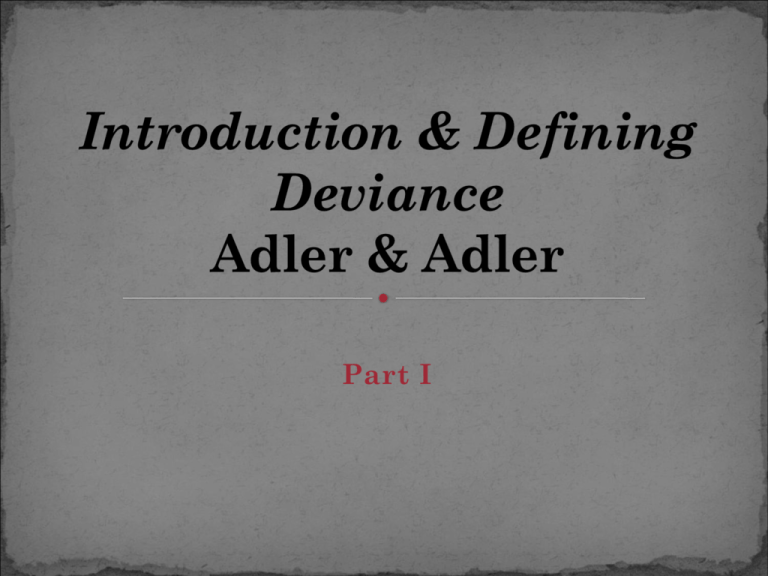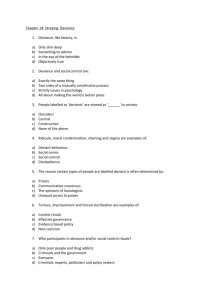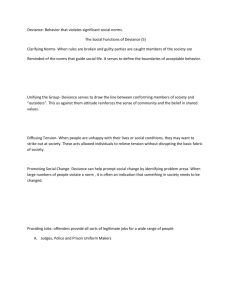Introduction & Defining Deviance Adler & Adler
advertisement

Part I Deviance is the violation of norms Anything that falls outside of what is considered “normal” Everyday norms based on custom, tradition, etiquette Examples: fashion norms, table manners, physical eye contact Violations are generally not seen as serious but may cause one to be viewed as odd or even avoided Moral norms based on social values Examples: interracial marriage, drug addition, extramarital relation Violations seen as more of a threat to social order, and the offender is seen as “bad” and perhaps harmful to society and its institutions Strongest norms since supported by formal code of sanctions Examples: murder, assault, rape, child pornography Violations may lead to imprisonment or even death Smith & Pollack (1976) reformulate Sumner: crime, sin and poor taste: Crime violates laws, sins are acts that contravene religious values; Poor taste involves violations of informal folkways First, some acts overlap such as crimes of violence that are both deviant and illegal Second, much deviance such as obesity or unwed pregnancy are non-criminal Third, certain criminal violations, such as Martha Stewart’s case, or acts of civil disobedience, do not bring moral censure. Conclusion: crime and deviance overlap with independent dimensions Being branded deviant for alternative attitudes or beliefs Examples: religious cult members, Satanists or political extremists such as terrorists. Mental illness also falls into this category. Overt acts that are regarded as deviant Examples: violating dress or speech conventions, kinky sexual behavior, using drugs, or violent acts Achieved deviant status: people cast into deviant label for overt act Seen as deviant for condition or quality that may be achieved or ascribed deviant status: Based on condition from birth about which the person can do nothing Examples: deviant socioeconomic status, the extremely poor or the very rich or having a congenital physical disability May also be achieved: Disfiguring oneself or getting full body tattoo During middle ages when religious paradigm prevailed, deviance viewed as religious disorder and sin attributed to satanic influence Exorcisms performed in order to exorcise demons from individual Medicalization of deviance used to explain drug use, sexual misbehavior, homosexuality, etc: Use of medical treatment for responding to deviance Certain behaviors seen as intentionally selected lifestyle choices or forms of recreation such as homosexuality, gambling, obesity What are the differences between folkways and mores? What distinguishes one from the other? Discuss the ABCs of deviance in the context of obesity and homosexuality. Part 1 Chapter 1 Part 1: Ch. 1 Every community occupies a specific space in the world geographically and culturally, which marks it as a special place, a reference point for its members A community maintains boundaries in the sense that its members tend to confine and limit themselves to a certain range of conduct and behavior Part 1: Ch. 1 Human communities maintain boundaries for the following reasons, to: retain a given pattern of consistent activity and behavior; make possible a degree of stability; retain cultural integrity Part 1: Ch. 1 How do people learn about boundaries? How do they convey them to the next generation? The only “material” for marking boundaries is members’ behavior: The networks of social interaction and relationships between members Several rituals or behaviors may mark boundaries such as wars, religious or public ceremonies Part 1: Ch. 1 But the most critical for publicizing boundaries are those which take place between deviant persons and official agents of the community, including: Criminal trials & punishment (executions) Excommunication hearings Courts-martial Psychiatric determinations of sanity Part 1: Ch. 1 Part 1: Ch. 1 Over time there are changes in group structure and leadership Changes in the surrounding environment The new generation may challenge the old guard Part 1: Ch. 1 Every public censure of a deviant act provides the community with opportunity to restate the group’s boundaries Given the utility of deviance for marking and reaffirming boundaries, does it make sense to assume that communities are organized to promote deviance? Consider that many of the institutions designed to discourage deviant behavior actually operate to perpetuate it: For example, prisons with high recidivism rates Part 1: Ch. 1 Commitment ceremonies such as trials are rites of passage for the offender which make it difficult for that person to avoid future deviance Involve formal stage of confrontation between society and the deviant Represent an announcement about the nature and limits of deviance Represent a more or less permanent change in a person’s status as deviant such as an exconvict who is not trustworthy This sets up a circularity, a “self-fulfilling prophecy” (Merton) Part 1: Ch. 1 How does society’s expectations of deviants lead to the “self-fulfilling prophecy”? What are some valuable functions of deviants? Part 1: Ch. 1






